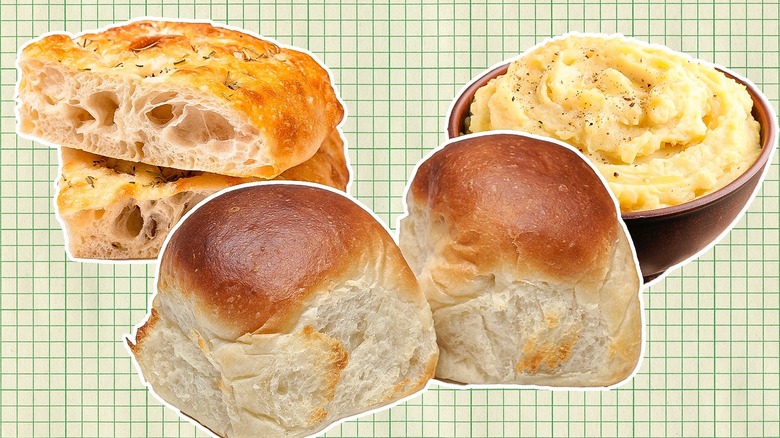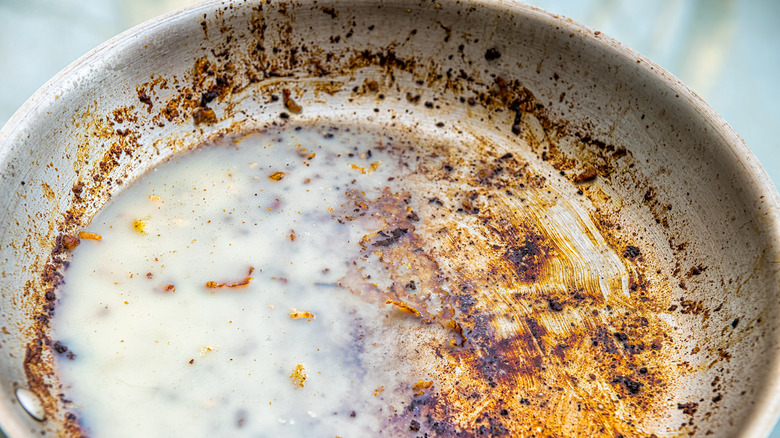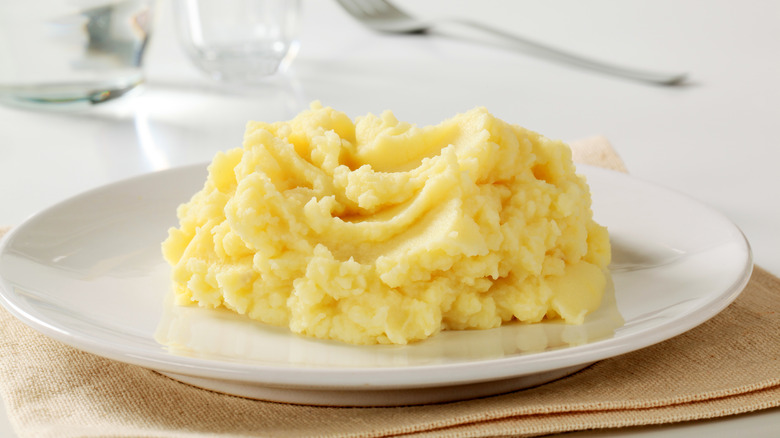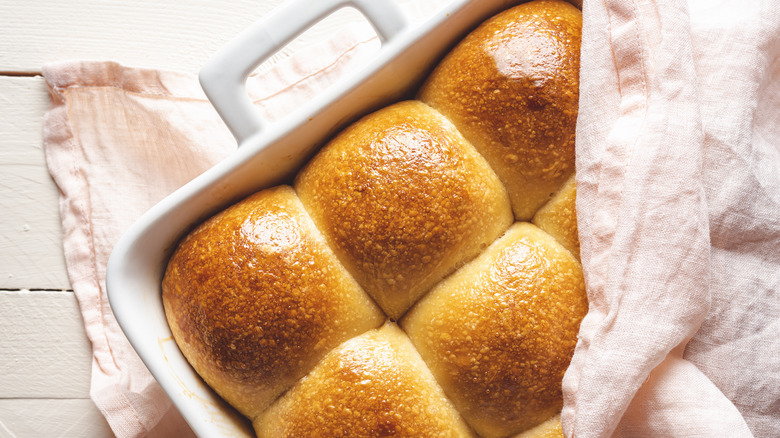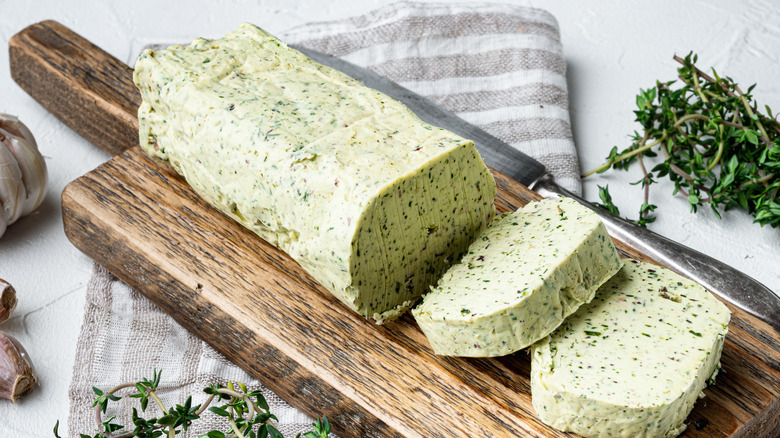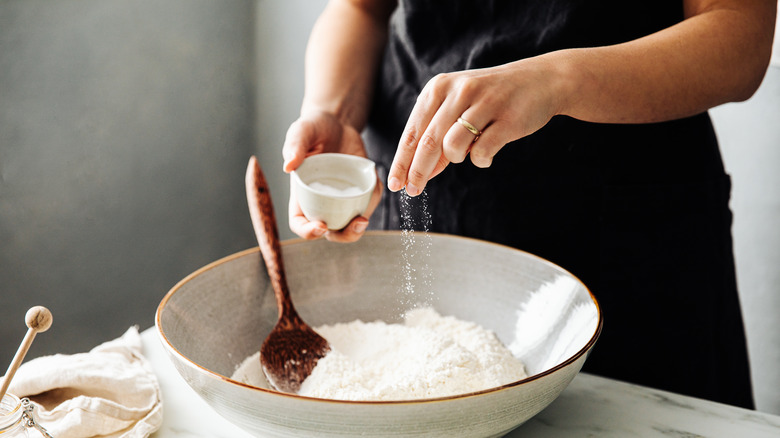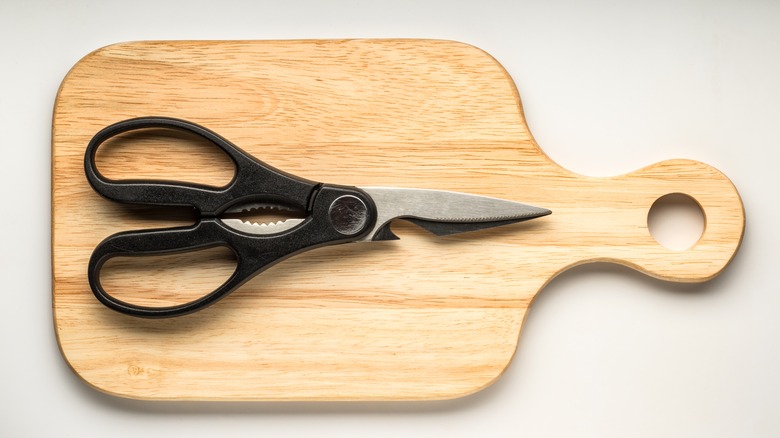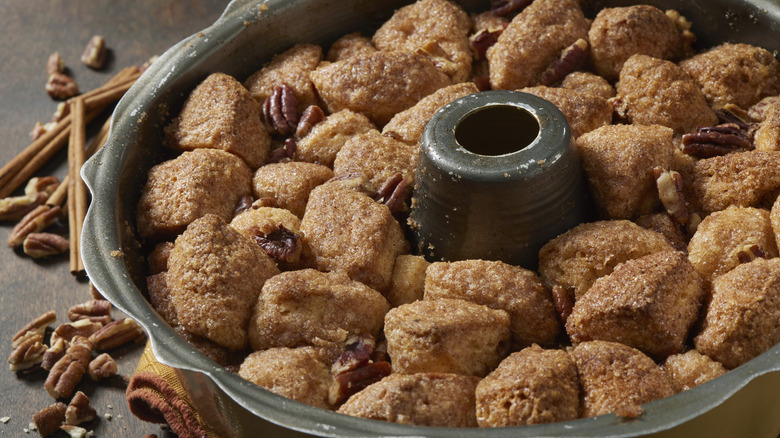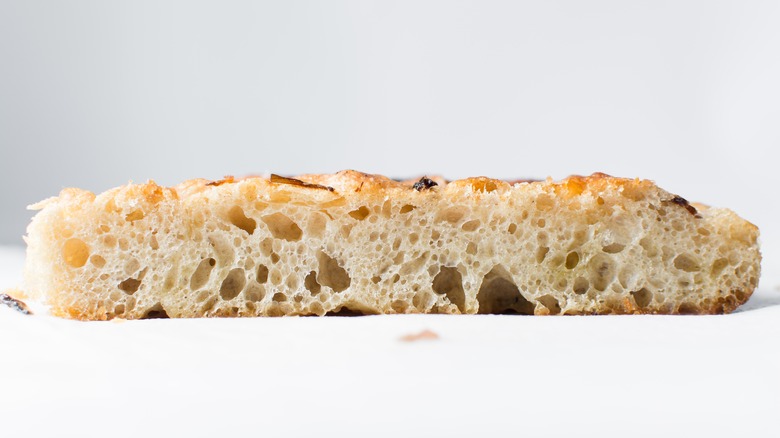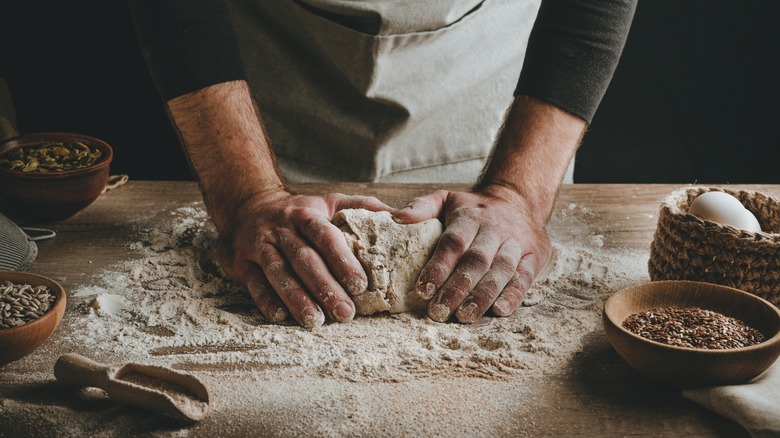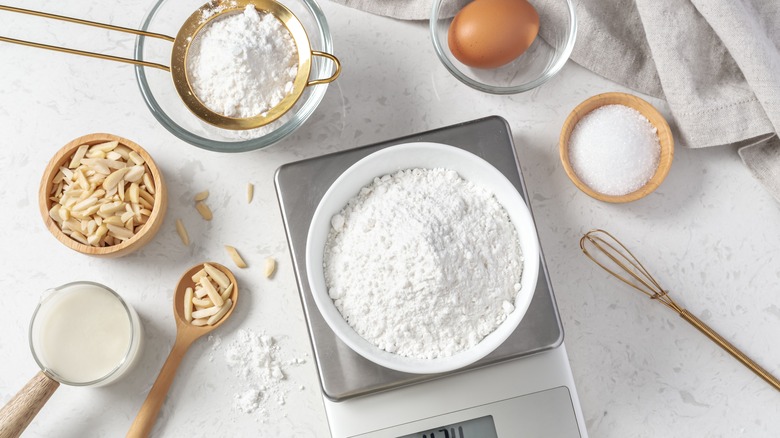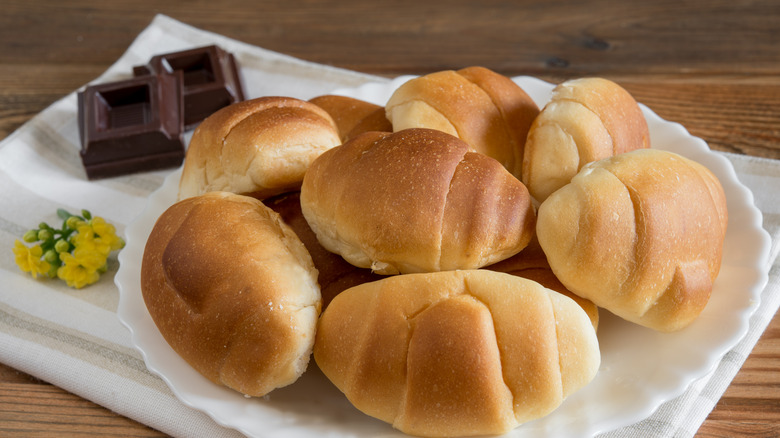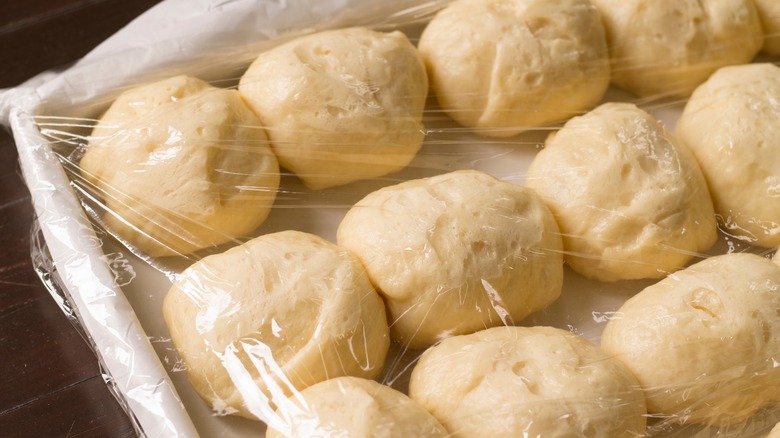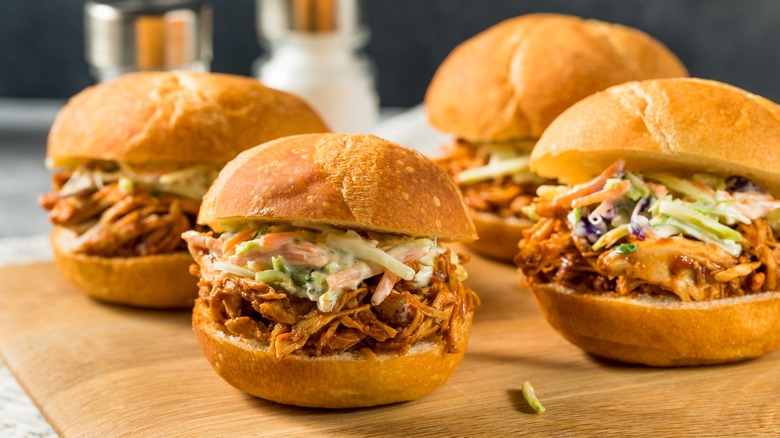13 Tips You Need For Making Dinner Rolls
Even though we have, for the most part, aged out of our early childhood eating patterns, we will shamelessly put a roll — and only a roll — on our plate during Thanksgiving dinner. The same applies when the basket of dinner rolls appears on the table at our favorite restaurant. How could anyone refrain from eating more than one, especially when it's topped with a massive pat of butter?
Dinner rolls don't just have to be plastic-wrapped boxes of take-and-bake dinner rolls from the grocery store. Rather, they can be flavored with unique butter, seasonings, and more to give them an unforgettable profile. And even though it might just be a side to the main entree, it still deserves the royal treatment.
We've curated a list of some of the best ingredients, cooking methods, and tips for making a fantastic batch of dinner rolls. Plus, we've also examined some of the biggest pitfalls that people often make with dinner rolls, along with how to prevent them and ensure that your batch rises to its fullest potential.
Add bacon grease for more flavor
Although the first thing most people do after they cook a pan full of bacon is drain the grease, we are adamant that holding onto the liquid gold is the best decision you can make.
There are two primary reasons we recommend adding bacon grease to store-bought rolls. The first is that the fatty components of your grease will create an illustrative shine on the outside of your rolls. It will make them just as good to look at as they are to eat. If you add the grease to the top of the rolls before sliding it into the oven, you'll notice that the grease also seeps down into the layers and helps encourage the perfect flake.
You'll also be able to pick up on the mild smoky notes of the meaty bacon underneath the layers of plush dough. While this might not be a suitable addition for plant-based eaters, we can assure you that the flavor you get from these bacon dinner rolls will change how you cook them forever.
Make your own recipe with mashed potatoes
The best and most creative ingredient additions often come from unlikely places. If you make your own batch of dinner rolls at home, you're probably reaching for simple ingredients like flour, yeast, and water. But what you should be grabbing is a bag of starchy potatoes.
Mashed potatoes are the key to dinner rolls that stay soft and fluffy, and this recipe owes a nod of appreciation to the delicious concoction we call potato bread. The best way to add this typical Thanksgiving side to your repertoire is to swap mashed potatoes for a recipe that calls for potato flour. Mashed potatoes are a better option than potato flour because they dramatically bring up moisture levels and potato undertone.
If you don't have a potato flour recipe, you can also swap out some of the traditional wheat flour in your recipe for mashed potatoes. Regardless, you may need to tweak your recipe to account for any additional dairy or salt in your potatoes. If you're in a rush, you can also add a boiled potato into the dough with a scant amount of the starchy cooking liquid before mixing it all together well. After all, nobody likes a suspiciously chunky roll.
Reheat them in the correct way
After you put so much time and effort into your dinner rolls, you better be able to enjoy the leftovers on day two. Unfortunately, dinner rolls are remarkably delicate and don't enjoy being reheated to the point where they become hot, golden-colored hockey pucks. Luckily, there are a ton of ways to bring your dinner rolls back to life without destroying their texture.
One of the more unconventional ways to reheat dinner rolls is to pop a batch in your slow cooker. Not only is this a great way to keep your rolls moist, but you can also use it to bring your frozen dinner rolls up to temperature. If you're using this technique for leftovers, simply pop the rolls in the slow cooker on top of a damp cloth or towel and leave them on low for about half an hour. Then, leave your rolls on the warm setting for about two hours to get them up to soft perfection. This tip is especially useful if you want warm rolls for a potluck or game-day recipe.
An alternative method, which is great for folks who haven't yet invested in a slow cooker, is to reheat your rolls in the oven. Rather than plopping them on a sheet pan, use a small, oven-safe dish to keep them nestled next to one another. A quick brush of butter will also help keep your little rolls perfectly moist.
Add more flavor to your rolls with a compound butter
Mixing, proofing, shaping, and baking your rolls is only half of the battle. You'll also need to decide how best to serve them to elevate and complement the existing flavors and textures.
Although most people's go-to ingredient is plain salted butter, there are ways you can subtly alter the profile of your fat with other ingredients. To add more flavor to your store-bought dinner rolls, use a compound butter instead. Compound butter not only allows more flavor to seep into the insides of your rolls, but it also allows you to add ingredients that would otherwise burn if they were left on the top of your rolls — like parsley or cheese.
To make a simple compound butter, like a 3-ingredient garlic butter, allow your salted butter to soften before whipping it in a bowl with parsley and minced garlic. Tuck it into an airtight container in your refrigerator for safe keeping, and spread it on the top of your grilled steak, as a base for your avocado toast, or tucked safely inside your dinner rolls.
Use a lower protein flour
Anyone who has ever made bread of any kind — including dinner rolls — will tell you that it is a meshing of both science and art. Not only do you have to feel what the perfect dough texture is like in your hands, which is often a technique learned through years of experience, but you also have to understand the science of how a combination of flour, yeast, and water eventually becomes a puffy piece of bread.
The flour is the ingredient that gives the roll its structure. Inside the flour are small gluten proteins, which, when activated with the water, will give your dough a springy texture. However, the flour mistake that makes dinner rolls as hard as rocks is starting with too much gluten in the first place. High-protein flours, like bread flour, will give your dinner rolls a more elastic structure, like the firmness found inside of a bagel. For a dinner roll, we want a soft texture with just enough gluten that the roll holds its shape.
You should always be sure to measure your flour correctly and stick with a lower protein version, like cake flour. Don't make a whole batch with this substitute, though, since it will create rolls that are too loose. Instead, swap out a portion of the all-purpose flour with cake flour.
Score your dinner rolls and make them look more professional
Your dinner rolls shouldn't just taste good — they should also look pretty darn enticing in a basket. To create fluffy crowned tops on your dinner rolls, grab a pair of clean kitchen shears. Grease the blades with a neutral oil and gently cut an X shape on the top of the rolls right before you're about to put them into the oven. When the rolls are baked, the score mark will crisp up and create a cool design, as well as add a bit of extra texture.
If you don't have a pair of kitchen shears, you can use a sharp bread lame to slice into your dough. This tool looks like a bread scalpel and is used to make clear, distinct score marks on bread dough. It's a must-have if you make bread frequently, but you can also swap it for a sharp knife if you don't want to fill up your draw with yet another kitchen gadget.
Make the most of your leftovers for a sweet treat
The best part about dinner rolls is that you can easily recycle them into other dishes, including desserts. Grab a basket of last night's dinner rolls and cut them up into small pieces for delicious, family-friendly monkey bread. Once your bread pieces have been cut into smaller chunks, roll them in a mixture of butter, cinnamon, and sugar and stick them into a greased bundt tin. After a quick bake in the oven, you'll find these pieces come out delectably gooey and ready to be dipped into a vat of sugary vanilla icing.
If you consider yourself to be an eater who doesn't like getting their fingers dirty, you might consider whipping up a bread pudding instead. You can easily indulge in a bowl using a fork and customize the spices to include other spices like cloves and cardamom or cover it in a warm caramel sauce.
Transform it into a focaccia
We love dinner rolls, but we admit that they don't always match every kind of cuisine — especially when it comes to Italian. Instead of popping them in the oven and serving them as individual buns, use frozen dinner rolls to make a last-minute focaccia.
Although your Italian grandmother may send you a torrent of judgment for swapping out fluffy, oil-covered focaccia with this avant-garde version, it will reduce the headache of dealing with tricky yeasted bread. Normally, a focaccia loaf requires many hours (and sometimes, even overnight) rise times, which can set back your dinner plans and send you to the store or local bakery to pick up an alternative anyway.
Start with a pack of thawed rolls that have been covered in a good-quality oil. You'll want to let the dough rise for about two hours if you're using a pre-made version. Once the dough is soft and fluffy, dimple it with your fingertips, add more oil and herbs, and bake it in the oven until it looks slightly fried on top.
Avoid over kneading your dough
Gluten is a wonderful thing, but it can also wreak havoc on the structure and consistency of your rolls. If your dinner rolls are coming out tough, it may be because you are handling them too much and are causing a major gluten overdevelopment. Even if you plop your dough into the stand mixer and walk away, the gluten strands in the dough are still forming, which in turn causes them to become super tense and strong. And while everything might seem fine when you proof it, when you take a bite, you'll find that your teeth will have to yank back on the dough to break off a piece.
If you notice your dough is starting to pull back when you knead it or it is difficult to slice or shape, it's an indication that it's due for a short nap before you can handle it again. Place the bowl with your dough on the counter, cover it with a towel, and let it rest for a bit before you come back to it.
Use your scale to get perfectly sized-rolls
Nobody wants to get the smallest roll in the basket, which is just one of the benefits of making sure your rolls are all evenly shaped. If you have some rolls that are larger or disproportionately shaped, it may cause them to bake at a different rate than your smaller, more delicate rolls. This can lead to poor color across a batch and rolls that are overbaked or underbaked. Maintaining uniformity assures that each dinner roll is as delicious as the next.
The easiest way to alleviate your sizing woes is to pull out your handy kitchen scale. Either divide the weight of the entire batch by how many rolls you plan to make or pick a roll size that works for you and go from there. Your kitchen scale is also a valuable tool for measuring ingredients, so it should be a staple in every home kitchen.
Try making an enriched recipe for better rolls
If you peruse the internet for dinner roll recipes, you'll find a lot of different ones. Some varieties are made with different ingredients, and one term you may see thrown about is an "enriched roll." The enriched dough has the same basic ingredients as a normal lean dough, including yeast, water, and flour, but it also contains a conditioning agent like oil, butter, milk, or eggs to give it a plush texture.
Although it might seem like it's a lot of extra work to transform a regular dough into an enriched one, the additional ingredients are important. The fat will encase itself around the gluten strands, which will shorten them and give the overall texture a more pillowy bite. The fatty ingredients can also slow down the yeast from doing its job, which will allow for more profound flavors. However, you should be advised that a slower fermentation period also means that you'll be waiting a bit longer for your rolls to be ready to bake.
If you're just starting out, we recommend going with a 5-ingredient yeast roll, which uses avocado or another neutral oil substitute. From there, you can try your hand at milk bread rolls, which have a much fluffier texture.
Follow the proofing directions to a T
One of the most common mistakes people make with recipes is refusing to follow the proofing time and instructions carefully. Generally, you can assume that every part of a recipe is there for a reason.
If you neglect to follow the proper guidance with dinner rolls, you can be sure that the result won't come out as you intended. Proofing, which is not the same as the first rising stage, occurs after the rolls have been shaped. The short period allows the dough to return to its fullest size after being poked and prodded into the desired shape. If you neglect to follow this step and instead toss your rolls right into a hot oven after shaping, they will likely come out with a dense crumb rather than the light, airy texture you're looking for.
One way to proof your rolls is to use your oven. Flip on the oven light, rather than turn the oven on, to get the perfect ambient temperature for your dough to proof. If your dough is going in the oven uncovered, you might also consider grabbing a bowl filled with water for the bottom of the oven. The water will gently steam and ensure your dough stays moist during this vital part of the bread-making process.
Use the leftovers for sliders
Dinner rolls share a similar shape to that of other rolls, so it's not surprising that you could use your leftover ones for other recipes. One of the best ways to make the most of your leftover dinner rolls is to fill them with your favorite fillings and pop them on a football-shaped plate with the rest of your tailgate favorites.
Our sheet pan sliders are regularly made with Hawaiian sweet rolls, but you can also swap them out with your leftover dinner rolls. If you want your toppings to resemble more of the taste and texture of a White Castle slider, you can top each with a brush of melted butter and a sprinkle of sesame seeds. You can stick to the standard burger filling or get more creative with a play on a Reuben — topped with Swiss, sauerkraut, and sliced corned beef with a generous portion of thousand island dressing.
